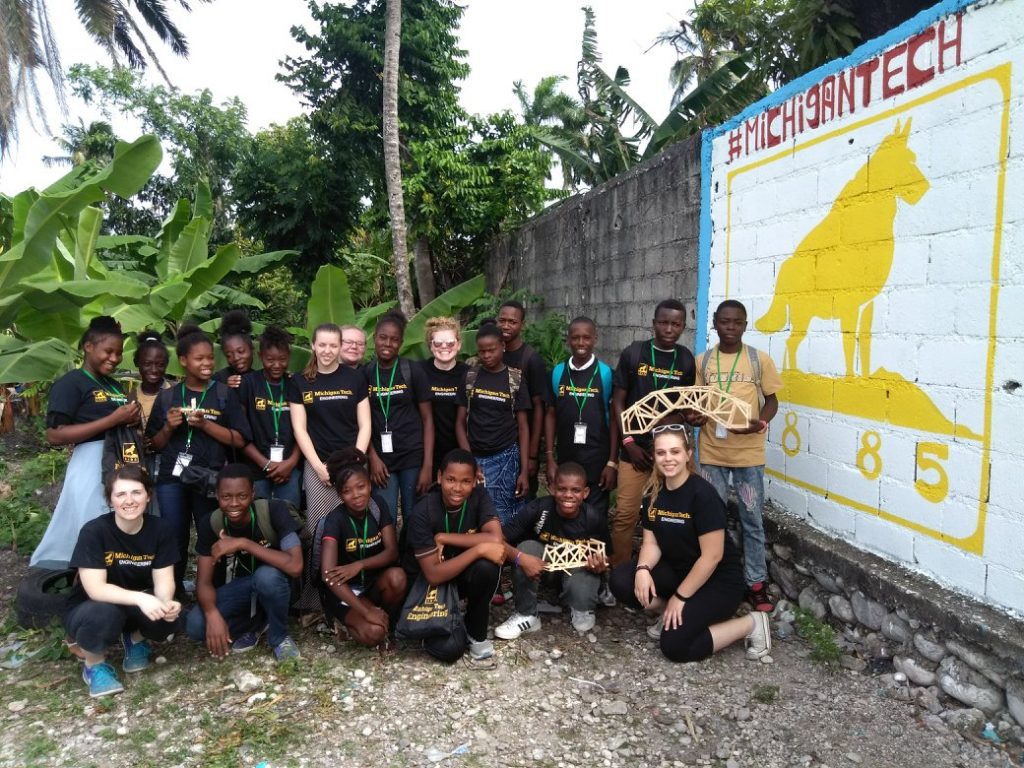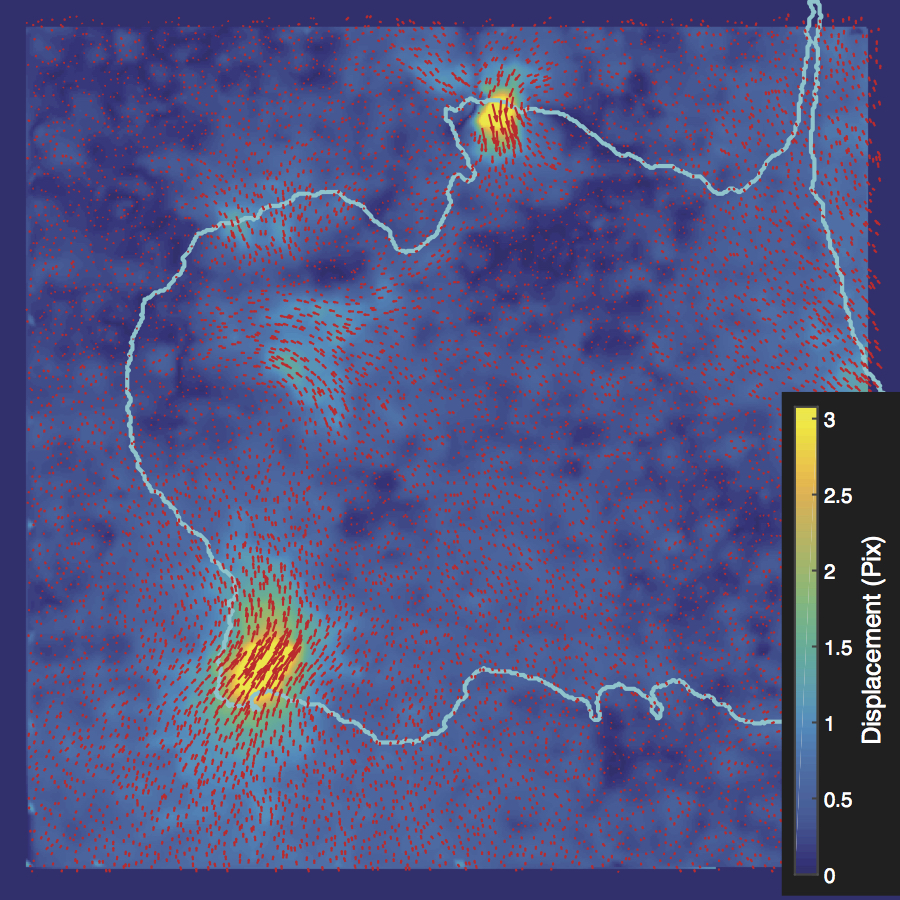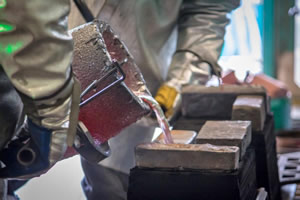
All are welcome at Michigan Tech’s 19th annual Design Expo, coming up on Thursday, April 19 in the Memorial Union Ballroom, from 8 am – 3 pm.
At Design Expo, you can explore the breadth and depth of undergraduate innovation, from more than 1,000 students from Michigan Tech’s Enterprise and Senior Design programs. More than 100 projects will be on display, judged throughout the day by a panel of corporate representatives, invited guests, and University faculty, staff, and graduate students. Many projects are sponsored by industry.
Below, check out the entire list of Senior Design and Enterprise teams competing.
SENIOR DESIGN TEAM PROJECTS, ADVISORS, AND SPONSORS
(listed by team number assigned by Design Expo for judging purposes)
201
Remote Switching Station Power
Advisor: John Lukowski, Electrical and Computer Engineering
Sponsor: ITC Holding Corp.
202
Automated Functional Testing Device for Logic Devices
Advisors: Aref Majdara and Tony Pinar, Electrical and Computer Engineering
Sponsor: Department of Electrical and Computer Engineering
203
Boat HUD
Advisor: Trever Hassell, Electrical and Computer Engineering
Sponsor: Systems Engineering Research Center (SERC)
204
Automated Functional Testing Device for Operational Amplifiers
Advisor: Aref Majdara, Electrical and Computer Engineering
Sponsor: Department of Electrical and Computer Engineering
205
Mobile Active Threat Emergency System (MATES)
Advisor: Paul van Susante, Mechanical Engineering-Engineering Mechanics
Sponsor: Air Force Research Labs
206
Electrostatic Precipitator Inspection Device
Advisor: Paul van Susante, Mechanical Engineering-Engineering Mechanics
Sponsor: DTE Energy
207
Hydro Generating Plant Black Start
Advisor: School of Technology
Sponsor: FDS Engineering & Electrical Services
208
Cobalt Reduction in Tribaloy T-400
Advisors: Paul Sanders and Walt Milligan, Materials Science and Engineering
Sponsor: Winsert Inc.
209
Assembly Cell Changeover
Advisor: William Endres, Mechanical Engineering-Engineering Mechanics
Sponsor: MacLean-Fogg
210
Cancer Detection
Advisor: Tony Pinar, Electrical and Computer Engineering
Sponsor: Barzin Moridian
211
Rapid Prototyping of Ultrasound Elastography Breast Phantom for Ductile Carcinoma Diagnosis
Advisor: Jingfeng Jiang, Biomedical Engineering
Sponsor: Materialise
212
Sorting of Bar Ends and Slugs from Hot-Formed Parts
Advisor: Paul van Susante, Mechanical Engineering-Engineering Mechanics
Sponsor: MacLean-Fogg Component Solutions
213
Ballnut and Ballscrew Inspection Data Post-Processing
Advisor: Steven Ma, Mechanical Engineering-Engineering Mechanics
Sponsor: Nexteer Automotive
214
Peripheral Tool Simulation for an Ultrasonic Aspirator Console
Advisor: Orhan Soykan, Biomedical Engineering
Sponsor: Stryker
215
Air Cooled Inverter Heatsink
Advisor: Jeremy Worm, Mechanical Engineering-Engineering Mechanics
Sponsor: US Army TARDEC
216
EPS ball screw lash measurement
Advisors: William Endres and James DeClerck, Mechanical Engineering-Engineering Mechanics
Sponsor: Nexteer
217
SERC MARSOC Improved Life Support for Casualties at Point of Injury
Advisors: Feng Zhao and Rupak Rajachar, Biomedical Engineering
Sponsors: Layne Lewis
218
Nodule Reduction on Steel Reheat Furnace Refractory
Advisor: Paul Sanders, Materials Science and Engineering
Sponsor: ArcelorMittal
219
Tinker Omega Sand Delivery System
Advisor: David Labyak, School of Technology
Sponsor: Department of Materials Science and Engineering
220
Automatic Case Sealer
Advisor: Eddy Trinklein, Mechanical Engineering-Engineering Mechanics
Sponsor: Fapco, Inc.
221
Gerdau Inclusion Solidification Prevention
Paul Sanders, Materials Science and Engineering
Sponsor: Gerdau – Monroe Mill
222
Fuel Economy Impact Tool
Advisor: Steven Ma, Mechanical Engineering
Sponsor: Maclean Fogg Component Solutions
223
Full Flexion Knee
Advisors: Jeremy Goldman and Keat Ghee Ong, Biomedical Engineering
Sponsor: Department of Biomedical Engineering
224
Data Analysis Methods to Improve Treatment of Chronic Pain
Advisor: Keat Ghee Ong, Biomedical Engineering
Sponsor: Medtronic
225
Transcatheter Single Ventricle Device
Advisors: Smitha Rao and Jeremy Goldman, Biomedical Engineering
Sponsor: Spectrum Health Innovations—Helen DeVos Children’s Hospital
226
SERC AFRL 05 Personnel Recovery – Power
Advisor: John Lukowski, Electrical and Computer Engineering
Sponsor: Systems Engineering Research Center
227
Micro-Pistoning Immobilization
Advisors: Bruce Lee and Feng Zhao, Biomedical Engineering
Sponsor: 3M
228
Load Sensor and Calibrator for Crane Control
Advisor: Fei Long, Mechanical Engineering-Engineering Mechanics
Sponsor: Department of Mechanical Engineering-Engineering Mechanics
229
Temperature Sensing of Implanted Medical Device Shields
Advisor: Keat Ghee Ong, Biomedical Engineering
Sponsor: Medtronic
230
Universal Driver Gear Train
Advisor: Smitha Rao, Biomedical Engineering
Sponsor: Stryker
231
Hard Surface Disinfectant Innovation
Advisor: Trever Hassell, Electrical and Computer Engineering
Sponsor: Leading Disinfectant Wipes Producer
232
AFRL – MATES
Advisor: Cam Hadden, Mechanical Engineering-Engineering Mechanics
Sponsor: Air Force Research Labs
233
Flow Meter for Power Plant Water Quality Analysis Equipment
Advisors: John Irwin and Sunil Mehendale, School of Technology
Sponsor: Sentry Equipment
234
Deposition System GUI
Advisor: Tony Pinar, Electrical and Computer Engineering
Sponsor: Chito Kendrick
235
TRIP Steel Additive Manufacturing
Advisor: Paul Sanders, Materials Science and Engineering
Sponsor: ArcelorMittal
236
Gypsum Water Extraction
Advisor: Paul van Susante, Mechanical Engineering-Engineering Mechanics
Sponsor: Michigan Tech’s MINE Enterprise
237
Laser Safety Proposal for Minerals & Materials Engineering Bldg. Room 329
Advisors: John Irwin, School of Technology, and Russell Stein and Paul Sanders, Materials Science and Engineering
Sponsor: Department Materials Science and Engineering
238
Effects of Scandium on Cast Iron
Advisor: Paul Sanders, Materials Science and Engineering
Sponsor: CleanTeQ
239
Clean TeQ Aluminum-Scandium Additive Manufacturing Alloy Development
Advisor: Paul Sanders, Materials Science and Engineering
Sponsor: Clean TeQ
240
Thermal & Mechanical Effects of Power Modalities on Surrounding Tissue
Advisors: Sean Kirkpatrick and Orhan Soykan, Biomedical Engineering
Sponsor: Stryker
241
Disposable Cranial Perforator System
Advisors: Jingfeng Jiang and Bruce Lee, Biomedical Engineering
Sponsor: Stryker
242
EPS Belt Drive Analytical Method to Predict Thrust Forces
Advisor: Aneet Narendranath, Mechanical Engineering-Engineering Mechanics
Sponsor: Nexteer Automotive
243
FCA Advanced Hood Architecture – Structural and Attachment Team
Advisor: Cam Hadden, Mechanical Engineering-Engineering Mechanics
Sponsor: Fiat Chrysler Automobiles
244
Catheter Hydrophilic Lubricious Coating Measurement Challenge
Advisor: Sean Kirkpatrick, Biomedical Engineering
Sponsor: Boston Scientific
245
Development of a Blubber-Only Whale Tag Anchoring System
Advisor: Rupak Rajachar, Biomedical Engineering
Sponsor: Dr. Alexandre Zerbini
246
Advanced Vehicle Hood Architecture and Design
Advisor: Jeremy Worm, Mechanical Engineering-Engineering Mechanics
Sponsor: Fiat Chrysler Automobiles
247
Automatic Rotary Indexer with Visual Feedback System for Fine Finish Tooling
Advisor: Eddy Trinklein, Mechanical Engineering-Engineering Mechanics
Sponsor: Endres Machining Innovations LLC
248
Pneumatic Flow Totalizer
Advisor: Jeremy Worm, Mechanical Engineering-Engineering Mechanics
Sponsor: Donald Engineering
249
Sand Point Tower and Boardwalk
Advisor: Steven Ma, Mechanical Engineering-Engineering Mechanics
Sponsor: Keweenaw Bay Indian Community
250
John Deere Gator XUV835 Exhaust Redesign
Advisor: James DeClerck, Mechanical Engineering-Engineering Mechanics
Sponsor: John Deere
251
Red Laser Inspection Device Improvement
Advisor: Eddy Trinklein, Mechanical Engineering-Engineering Mechanics
Sponsor: MacLean-Fogg Component Solutions
252
Mobile Active Threat Emergency System
Advisor: William Endres, Mechanical Engineering-Engineering Mechanics
Sponsor: Air Force Research Labs
253
Eddy Current Inspection In-line Integration
Advisor: William Endres, Mechanical Engineering-Engineering Mechanics
Sponsor: MacLean-Fogg Component Solutions — Metform
—
ENTERPRISE TEAMS, ADVISORS, AND SPONSORS
(listed by team number assigned by Design Expo for judging purposes)
101
Blizzard Baja
Advisor: Kevin Johnson, Mechanical Engineering Technology
Sponsors: Aramco, Denso, General Motors, FCA, Magna, 3M, Altair, Ford Motor Company, Halla Mechatronics, Henkel, IPETRONIK, John Deere, Meritor, Nexteer, Michigan Scientific Corporation, Milwaukee Tool, ArcelorMittal, Cummins, Oshkosh Corporation
102
Clean Snowmobile Challenge
Advisor: Jason Blough, Mechanical Engineering-Engineering Mechanics
Sponsors: Aramco, Denso, General Motors, FCA, Magna, 3M, Altair, Ford Motor Company, Halla Mechatronics, Henkel, IPETRONIK, John Deere, Meritor, Nexteer, Michigan Scientific Corporation, Milwaukee Tool, ArcelorMittal, Yamaha, Kohler, Arctic Cat, Camso, V-Converter, Bosch, PCB Piezotronics, TE Connectivity, Simscale
103
Formula SAE
Advisor: James DeClerck, Mechanical Engineering-Engineering Mechanics
Sponsors: Aramco, Denso, General Motors, FCA, Magna, 3M, Altair, Ford Motor Company, Halla Mechatronics, Henkel, IPETRONIK, John Deere, Meritor, Nexteer, Michigan Scientific Corporation, Milwaukee Tool, Simscale, TE Connectivity, Mercury, SKF USA, PartSolutions, ArcelorMittal, McLaren, AVL
104
Supermileage Systems
Advisor: Rick Berkey, Pavlis Honors College
Sponsors: Aramco, Denso, General Motors, FCA, Magna, 3M, Altair, Ford Motor Company, Halla Mechatronics, Henkel, IPETRONIK, John Deere, Meritor, Nexteer, Michigan Scientific Corporation, Milwaukee Tool, ArcelorMittal, Saginaw Controls & Engineering
105
Advanced Metalworks Enterprise (AME)
Advisor: Paul Sanders, Materials Science and Engineering
Sponsors: Mercury Marine, Eck, ArcelorMittal, Gerdau, Clean TeQ, AIST
106
Aerospace Enterprise
Advisor: L. Brad King, Mechanical Engineering-Engineering Mechanics
Sponsors: NASA, Air Force Research Laboratory
107
Alternative Energy Enterprise (AEE)
Advisor: Jay Meldrum, Keweenaw Research Center
Sponsors: Keweenaw Research Center, Oshkosh, and Traverse Solar
108
Blue Marble Security
Advisor: Glen Archer, Electrical and Computer Engineering
Sponsors: General Motors, Oshkosh Corporation, ArcelorMittal, Systems Engineering Research Center (SERC)
109
BoardSport Technologies
Advisor: Ibrahim Miskioglu, Mechanical Engineering-Engineering Mechanics
Sponsors: ArcelorMittal, Enterprise Manufacturing Initiative funded by General Motors, Pavlis Honors College
110
Built World
Advisor: Audra Morse, Civil and Environmental Engineering
Sponsors: Airport Cooperative Research Program University Design Competition
111
Cin/Optic Communication and Media
Advisor: Erin Smith, Humanities
Sponsors: International Research Experience for Students (IRES), Michigan Tech Dept. of Mechanical Engineering-Engineering Mechanics, Michigan Tech School of Technology, Community Solar
112
Consumer Product Manufacturing
Advisors: Tony Rogers and Sean Clancy, Chemical Engineering
Sponsors: Avery Wilson, General Motors, Kohler Company, Libbey Inc., Yanfeng Automotive Interiors, Robert Carnahan, Schmohz Brewing Company, Keweenaw Brewing Company, ArcelorMittal
113
General Expedition and Adventure Research (GEAR)
Advisor: Brett Hamlin, Engineering Fundamentals
Sponsors: Systems Engineering Research Center (SERC), Enterprise Manufacturing Initiative funded by General Motors
114
Green Campus
Advisor: Christopher Wojick, Civil and Environmental Engineering
Sponsor: Michigan Technological University
115
Humane Interface Design Enterprise (HIDE)
Advisor: Robert Pastel, Computer Science
Sponsor:
116
Husky Game Development
Advisor: Scott Kuhl, Computer Science
Sponsor:
117
Innovative Global Solutions
Advisor: Radheshyam Tewari, Mechanical Engineering-Engineering Mechanics
Sponsor: Pavlis Honors College, the Enterprise Manufacturing Initiative funded by General Motors
118
ITOxygen
Advisor: Russell Louks, School of Business and Economics
Sponsors: Microsoft, 24G, Denso, Pavlis Honors College
119
Mining Innovation Enterprise (MINE)
Advisor: Paulus Van Susante, Mechanical Engineering-Engineering Mechanics
Sponsor: NASA
120
Open Source Hardware
Advisor: Joshua Pearce, Materials Science and Engineering
Sponsors: Enterprise Manufacturing Initiative funded by General Motors, ArcelorMittal
121
Robotic Systems
Advisor: Jeremy Bos, Electrical and Computer Engineering
Sponsors: General Motors, SAE International, Continental, Intel, MathWorks, Velodyne
122
Strategic Education through Naval Systems Experiences (SENSE)
Advisor: Andrew Barnard, Mechanical Engineering-Engineering Mechanics
Sponsors: Keweenaw Bay Indian Community (KBIC), Systems Engineering Research Center (SERC), Office of Naval Research (ONR)
123
Velovations
Advisor: Steve Lehmann, Mechanical Engineering-Engineering Mechanics
Sponsors: Ak Tube LLC, ArcelorMittal, Boss Snow Plow, Churning Rapids Snow Bike Trail, Pavlis Honors College
124
Wireless Communication Enterprise (WCE)
Advisor: Christopher Cischke, Electrical and Computer Engineering
Sponsors: Ford Motor Company, Systems Engineering Research Center (SERC), Michigan Tech Dept. of Electrical and Computer Engineering, and Michigan Tech Dept. of Visual and Performing Arts
125
High School Enterprise—Dollar Bay School SOAR
Advisor: Joshua Pearce, Materials Science and Engineering
Sponsors: DBTC Area Schools, Lake Superior Stewardship Initiative


















